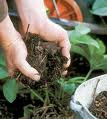1
Backyard Composting
Pick a spot. Partial shade is ideal because the shade will prevent the pile from drying out too fast and the sun will help the decomposition process. Good drainage is important. Avoid placing the pile adjacent to wood (like a fence or building) or under acid producing trees like pine, black walnut or juniper.
Pick a container (or not). A container is not essential but helps make the pile neat and tidy. Good air circulation is a must. A container can be as simple as wire mesh formed into a circle, or as fancy as a rotating drum that mixes the compost by the turn of a handle.
Add materials. There are many "recipes" for making good compost. You can even add a "starter" to the mix to speed up the activation process. The smaller the pieces, the faster it will compost. Avoid meat, dairy and high fat materials, seed producing weeds and bug-infested plants. The heat may not get high enough to kill them.
Turn the pile occasionally to mix materials and add air to the process.
Harvest your compost and use in gardens, around flowers, and as a soil amendment.
Other Compost Links:
2
3
4
5














